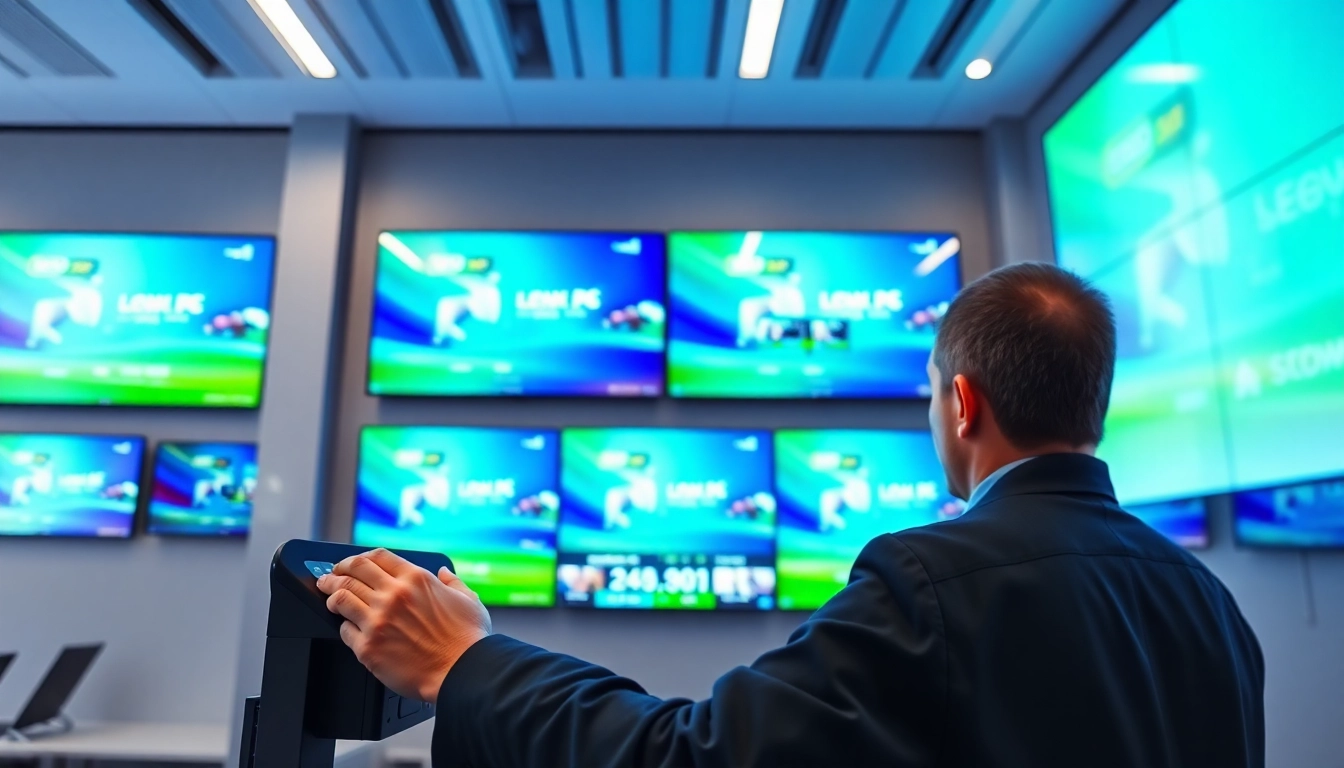Understanding Multi-Screen Digital Signage Management
In today’s digital landscape, Multi-screen digital signage management plays a pivotal role in enhancing communication and engagement strategies across various sectors. Utilizing multiple displays not only amplifies the visibility of information but also facilitates the creation of dynamic and interactive visual experiences that resonate with audiences. This comprehensive guide delves into the intricacies of managing multi-screen digital signage, exploring its benefits, challenges, tools, and future trends.
What is Multi-screen Digital Signage Management?
Multi-screen digital signage management refers to the orchestration and control of content across various digital displays simultaneously. This format transcends traditional single-screen setups by enabling businesses to present cohesive and interactive content across multiple platforms, essentially creating a unified visual storytelling experience. Management solutions usually comprise both software and hardware components that allow for real-time updates, scheduling, and content curation, overlaying complex datasets with aesthetically pleasing formats.
Key Benefits of Multi-screen Digital Signage Management
- Enhanced Visibility: Businesses can showcase advertisements, information, and branding across numerous screens, increasing reach and impact.
- Dynamic Content Presentation: Multi-screen setups allow for varied content types, including videos, animations, and live feeds, making the viewer’s experience richer.
- Improved Audience Engagement: By utilizing interactivity and responsive content, businesses can engage audiences more meaningfully.
- Operational Efficiency: Simplified management systems can streamline content updates and performance monitoring across all displays from a single platform.
- Flexibility and Customization: Organizations can tailor their content based on location, time, and audience, providing a personalized experience.
Common Use Cases Across Industries
Multi-screen digital signage is applicable across various sectors, providing innovative solutions tailored to specific needs:
- Retail: Create immersive shopping environments with product displays, promotions, and wayfinding information to enhance customer experience.
- Transportation: Airports and train stations employ multi-screen setups for real-time updates on schedules, wayfinding, and customer service announcements.
- Healthcare: Hospitals and clinics leverage these systems for patient information, directions, and health announcements, thereby improving patient flow and experience.
- Corporate: Companies utilize multi-display setups for presentations, internal communications, and branding at conferences and corporate events.
- Education: Schools and universities can employ multi-screen environments for announcements, event promotions, and educational content.
Challenges in Implementing Multi-Screen Digital Signage Management
While multi-screen digital signage brings numerous benefits, it does not come without its challenges. Understanding these challenges is pivotal for organizations looking to implement an effective multi-screen strategy.
Technical Hurdles and Solutions
Technical issues may arise during setup and operation, including connectivity failures, content synchronization problems, and compatibility with different hardware.
Solutions include adopting robust software that allows seamless integration of various devices, thorough testing of network infrastructure before deployment, and ensuring that all screens are synchronized to prevent content lag or misalignment.
User Experience Concerns
User experience is central to the effectiveness of multi-screen displays. Issues such as overwhelming content, poor visibility from certain angles, or distraction can hinder engagement.
To address these concerns, businesses can implement user-centric design principles, ensuring that content is not only relevant but also visually engaging and easy to comprehend. Clear signage and intuitive navigation can also enhance user experience.
Maintenance and Upkeep Challenges
Ongoing maintenance is essential for the longevity of multi-screen systems. Displays require regular updates for both hardware and software, and failing to do so can lead to technical failures or diminished performance.
Establishing a routine maintenance schedule, utilizing remote monitoring tools, and training staff in basic troubleshooting can mitigate many common upkeep issues.
Tools and Technologies for Multi-Screen Digital Signage Management
The right technology is essential for effective multi-screen digital signage management. Below, we explore key tools and technologies.
Software Solutions That Simplify Management
Various software solutions facilitate the management of content across multiple displays, enabling users to schedule, update, and curate content remotely. Effective software should feature:
- Intuitive user interface for ease of use
- Cloud-based options for real-time updates and scalability
- Capability to manage multi-user access and roles for greater collaboration
- Analytics and reporting tools to track engagement and performance metrics.
Hardware Requirements and Recommendations
Alongside software, organizations should invest in reliable hardware, including:
- Digital Displays: Select high-definition displays with wide viewing angles for optimal visibility.
- Media Players: Choose robust media players that can handle intensive graphics and video playback.
- Networking Equipment: Invest in high-speed internet and networking hardware to support seamless content delivery across multiple screens.
Integrating Multi-screen Systems with Existing Infrastructure
Successful integration of multi-screen systems with existing infrastructure can maximize utility while minimizing disruption. Key considerations include:
- Compatibility with current hardware and software solutions.
- The ability to leverage existing content management systems.
- Future-proofing the system to accommodate growth and changes in technology.
Best Practices for Optimizing Multi-Screen Digital Signage Management
To achieve optimal results with multi-screen digital signage management, consider these best practices:
Content Creation and Curation Strategies
Developing compelling content is critical. Use storytelling techniques to create narratives that engage viewers. Ensure that content is tailored to the specific contexts in which it will be displayed — whether that’s time-sensitive promotions in retail or informational updates in a healthcare setting.
Measuring Performance and Engagement Metrics
To assess the effectiveness of digital signage, organizations should track key performance indicators (KPIs) such as audience engagement, dwell time, and conversion rates. Leveraging data analytics tools can provide insights into content performance and help refine strategies over time.
Adapting to Audience Feedback and Analytics
Engagement with the audience should be a two-way street. Listening to feedback and analyzing trends in viewer behavior will enable organizations to adapt their content and strategies accordingly. Surveys, social media interactions, and real-time analytics are valuable resources for gathering insights and making informed decisions.
Future Trends in Multi-Screen Digital Signage Management
The landscape of multi-screen digital signage management is evolving. Here are some anticipated trends that organizations should prepare for:
Emerging Technologies and Innovations
As technology continues to advance, emerging solutions such as artificial intelligence (AI) and machine learning are enhancing the capabilities of digital signage. These technologies can personalize content delivery and optimize performance through predictive analytics, allowing for adaptive and responsive signage based on audience behaviors.
Shifts in Consumer Behavior and Expectations
Consumer behavior is increasingly leaning towards personalized experiences. Future multi-screen systems will likely focus on delivering customized content that caters to individual preferences, factors such as location, and time of day.
Preparing for the Next Generation of Digital Signage
Organizations should stay attuned to technological developments, fostering agile strategies that can adapt to shifting trends and innovations in digital signage. Exploring partnerships with technology providers and regularly updating systems will ensure that businesses remain competitive in a rapidly evolving market.




